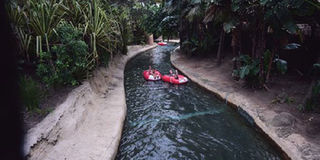Taking in Durban’s history lesson bit by bit

Tourists enjoy a water ride. Photo Edgar R. Batte
What you need to know:
- Discover. Durban is the third most populous city in South Africa after Johannesburg and Cape Town and the largest city in the South African province of KwaZulu-Natal. A tour guide explains to Edgar R. Batte a bit more about the city.
Tour guides and operators play a big role in making an excursion worthwhile. Shiney Bright is one of such who made our visit to Durban, South Africa, a beautiful experience. She is knowledgeable, friendly and dynamic.
“Correct me if I am wrong but people like to move around in Africa as it is not such a big leap as going to, say Spain, where it has a different language, food, etc,” she says, affording a coy smile.
When we break ice, while on a familiarisation trip in ‘the warmest place to be’, that is Durban, the British born tour guide tells me of many Ugandans she had hosted and taken around, the last group having enjoyed her company on New Year’s Day.
Warmth of people
Durban and Kampala are miles apart but share the commonality of warm days with the temperature of the two cities averaging at 27°C. Just like Kampala, Durban also has warm people that endears them to visitors with a communal attitude.
Bright adds, “So coming further south there is still the “warmth” and “friendliness” that you are used to at home Also, like other parts of Africa, we have had the colonial stamp of which “parts were good and parts were bad”. Our city is young (1826) compared to Cape Town.”
The indigenous tribe of Zulu are famous for their courage supporting England in the two World Wars. Your writer is able to hear more stories as he is chauffeured around, along with fellow journalists from Africa.

Panoramic view of Durban. Shiney Bright, a tour guide makes a point. Photo by Edgar R. Batte
“The worst part of the history began in 1948 with the creation of the Republic of South Africa by the Nationalist Party who managed to win the election over the Unionists and started to put into law the separation of different ethnic groups. This lasted 46 years.”
Scars such as these have left a blot on humanity.
However, the infrastructure created was modern and worked well so the city has plenty of modern elegant hotels and shopping malls. The sandy beaches run all the way up to and past Mozambique and the Indian Ocean never drops below 17°C and can be like bathwater in the summer. As the guide adds, the beaches are protected from shark attacks and have lifeguards if necessary as many people cannot swim.
While you ply the beaches, ask your guide to include a visit to the Ushaka Marine World whose arty and enormous tanks show the creatures from the sea, including sharks, turtles and rays followed by a dolphin show.
Infrastructure
Nineteen kilometres further North is Umhlanga which as Bright explains, was created by the Sugar Industry after 1994 when all the segregation laws were repealed; the roads were redirected and panoramic land sold to build beautiful houses. Modern shops and offices were snapped up by investment companies, banks, lawyers etc so they could gaze at the oceans and park their cars – which wasn’t possible in the city of Durban.
“Large areas were set aside for a “village” of individual private houses with high security, sports facilities in an indigenous setting with antelopes and many kinds of birds – called Zimbali or flowers in Zulu. The Fairmont Hotel is here too, so sit back and relax after your round of golf tennis match,” she further narrates.
Sugar places and tribes
Further north there are smaller towns such as Stanger, a centre of the sugar plantations where farmers are enjoying some commercial rewards. Bright jokes that every farmer ‘must have’ a new Mercedes every year. As she adds, when the British set up the sugar industry back in the early 1800s they realised that their plans for the Zulus to cut the cane were not going to work as the Brits did not understand their pride as menial tasks of cultivating vegetables were left to the women.
So, plan B evolved and off they went to bring Indians from Southern India where they grow rice and fruit and spices to cut the cane. The descendants of these people are still there although they did have a choice to return to India once the five-year contract was up, but they preferred to live here where the “caste” system did not exist. So, if you go to Stanger, you may not even see white people as the town is run by both Indian and Zulu.
Bottom-line
“Once you cross the Tugela river, you are now in old Zululand. This was known as a Homeland and each tribe had them in the various parts of the country,” she says.
Nelson Mandela was Xhosa from the Eastern Cape and as she further narrates, the area was known as the Transkei. There was also the Ciskei (the Kei being a river) and many more.
About
Durban
A coastal city in eastern South Africa’s KwaZulu-Natal province, is known for its African, Indian and colonial influences. Refurbished for soccer’s 2010 World Cup, the seafront promenade runs from uShaka Marine World, a huge theme park with an aquarium, to the futuristic Moses Mabhida Stadium. The Durban Botanical Gardens showcases African plant species.




